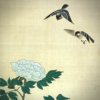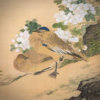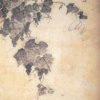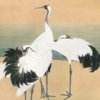Tsutaya Ryūkō: The Unknown Genius of Yamato-e Paintings
’Botan Shō-Karajishi (Peonies and a Small Beast)’

Tsutaya Ryūkō was born in Hirosaki, Aomori Prefecture, in 1886. Upon moving to Tokyo, he entered the program of Japanese Painting at the Tokyo Fine Arts School and supported himself throughout his academic life until graduating in 1910. He later became an apprentice to Terasaki Kogyō, who also hailed from the Tōhoku region, specifically Akita, and devoted himself to studying yamato-e. His work was selected for the first time at the ninth Bunten exhibition of 1915 and thereafter attracted attention for being awarded the highest prize at the 12th Bunten exhibition of 1918, the second Bunten exhibition of 1920, and the third Bunten exhibition of 1921. Afterward, he frequently served as a judge for Teiten exhibitions. Having been an avid drinker his whole life, he died at the mere age of 47 in 1933 from a brain hemorrhage.
Accumulating experience in studying yamato-e, Ryūkō strived to pioneer a new world of the painting style. The world that he envisioned slightly differed from that of the works of Matsuoka Eikyū, another yamato-e painter from around the same time period, who was known for his traditional style and colors, and was a prominent figure of Shinkō Yamato-e Kai. Unlike Eikyū, whose works were composed of lines and colors, Ryūkō did not utilize lines and applied colors in a method that deviated from the conventional yamato-e method. It could be said that his works were created with a modern man’s interpretation of yamato-e. As written in his own words, Ryūkō admired old artworks from Nara and Kyoto, and frequently left his home in Tokyo, a place of turbulence, to travel to the two cities. The following are his written words:
‘Once I get here, I usually stay for three to four months, I think it’s fair to say that my real life belongs here. Nara and Kyoto aren’t simply for my hobbies or making myself feel like I’m on vacation – they are intimately related to my art and work. ‘
In such ways, Ryūkō was in contact with old Japanese artworks from Nara and Kyoto, and his works display the outcomes of his studies. It should also be noted that not all of the outcomes are visible – many aspects of them are internal and spiritual. This work came to form from his studies in classic art. Although he uses ultramarine, blue-green, and gold paint, the work itself was made with a completely modern approach, and anything in the painting, from the depiction of peonies to the posture and style of the beast, do not follow a formerly conceived style. It could also be said that Ryūkō’s stance towards the classics and his perception of his own creations are visible in this type of work.










